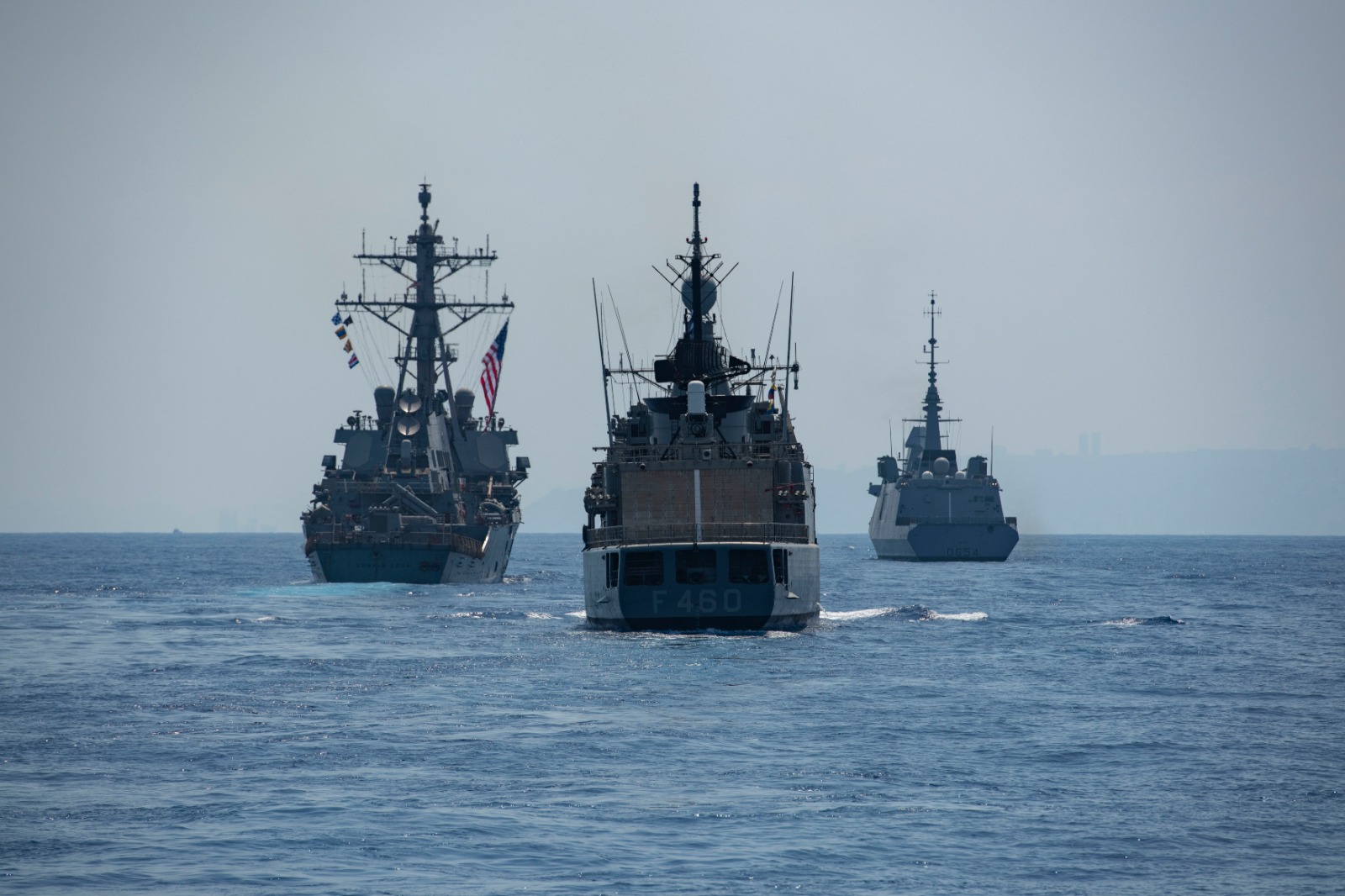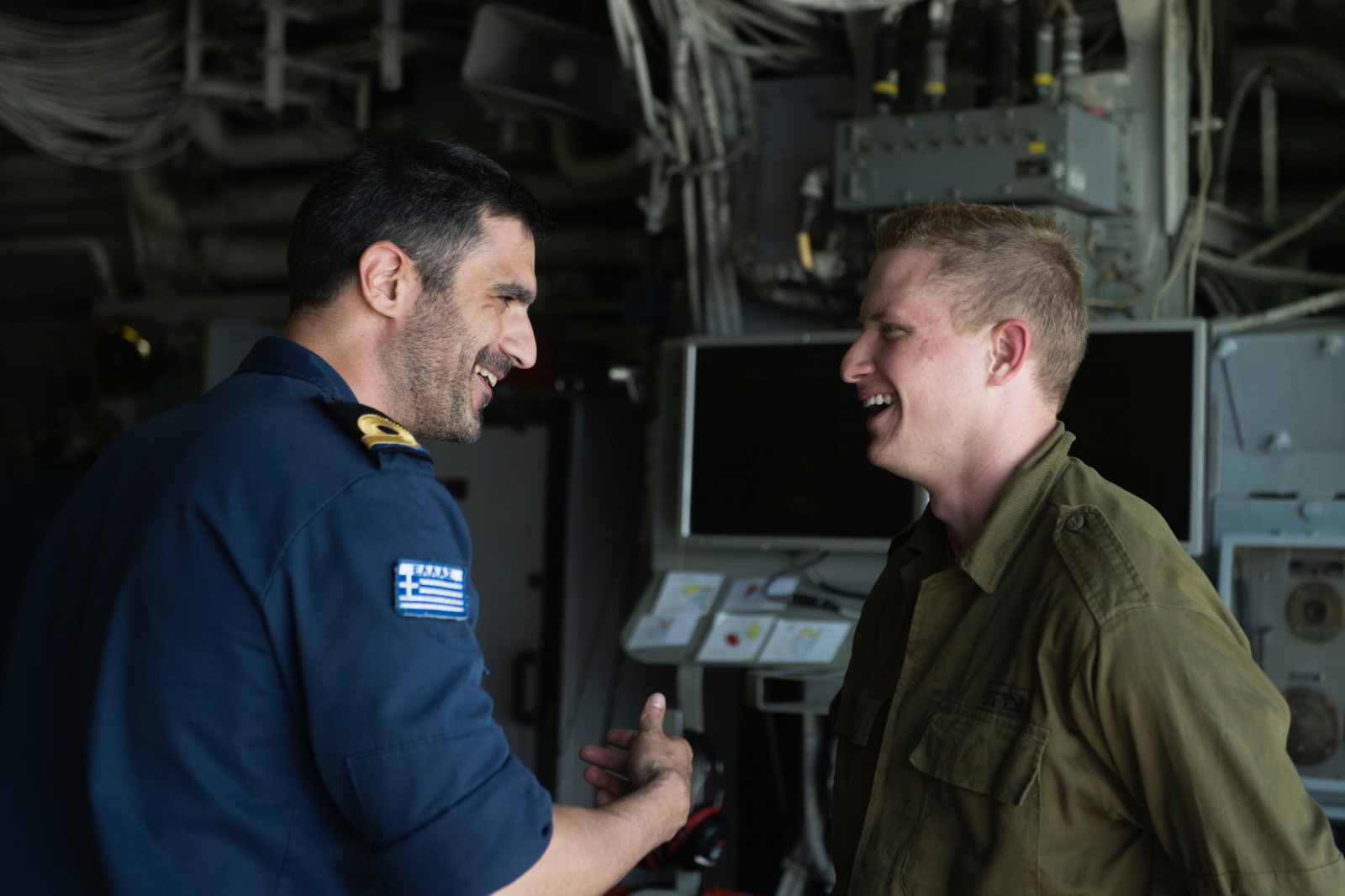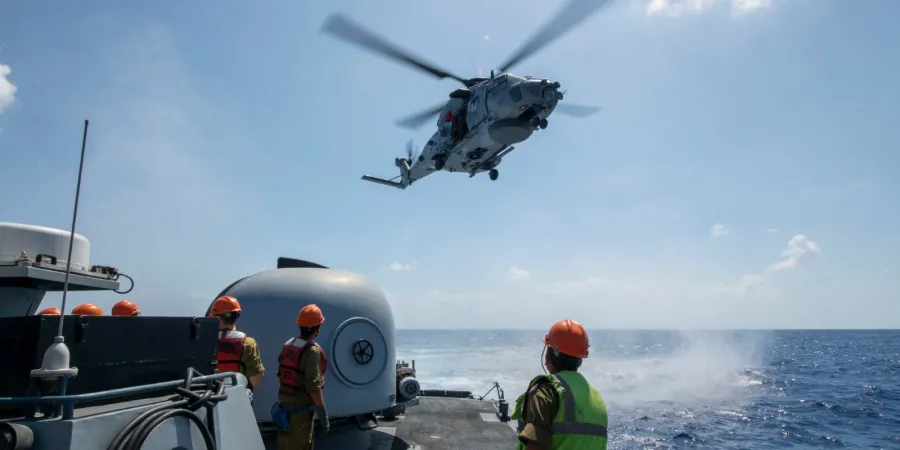Israeli Navy Leads International Exercise Simulating Major Earthquake
The IDF Naval Arm has recently completed a joint training exercise with ten other naval forces that simulated a major earthquake hitting Israel. This was the first time that the Navy has carried out an exercise focused on earthquake response
Or Heller
| 13/08/2019
The IDF has recently completed a joint international training exercise designated "Mighty Waves," conducted under the guidance of the IDF Navy. The exercise simulated a scenario where a powerful earthquake hit the State of Israel. In the context of the exercise, the participating naval forces performed joint medical drills, surface and underwater rescue/extrication exercises, live-fire exercises, and formation drills.
Israeli civilian elements and ten other naval forces took part in the Mighty Waves exercise along with the IDF Naval Arm. The naval forces of the US, France, and Greece were represented by naval vessels. Additionally, Cyprus, Chile, Italy, Germany, Canada, the UK, and NATO sent staff officers to participate in the exercise.
The drill, said to be Israel's largest-ever naval exercise, simulated a 7.5-magnitude quake that claimed the lives of 230,000 people and caused the collapse of 250 buildings, as well as disabling key infrastructure and affecting the lives of 3 million people.
VADM Eli Sharvit, Commander of the IDF Navy, said the exercise reflected a significant marine operation. "We assign the utmost importance to exercises of this type for reinforcing the connections between the IDF Navy and the foreign naval forces with whom we expect to cooperate in the context of different and diversified events."

RADM Gil Aginsky, Commander of the IDF Navy's Haifa base, said that "The goal of the exercise was to promote cooperation and coordination with several navies with regard to search and rescue and humanitarian aid in our country. The exercise had four objectives: to conduct a marine training exercise; to establish cooperation not just between foreign naval forces, but also between organizations such as the IDF Operations Directorate, the IDF Planning Directorate and the IDF Navy, the Israel Ministry of Foreign Affairs, the Port of Haifa, the Rambam Hospital and others; readiness/preparedness was the third objective, based on the realization that an earthquake scenario is a reasonable eventuality in the State of Israel, so we thought it would be the right thing for us to face such a situation in a prepared state – and there is a lot to be learned from foreign navies and from events that had occurred around the world; coalition – based on an analysis of past scenarios, we realized that when you operate in a coalition, the whole is greater than the sum of its parts."
"In order to face the scenario in a better-prepared state, we regarded the earthquake of 2010 in Haiti as a blueprint," RADM Aginsky added. "We did not want to start from zero, so we took all of the analyses and went on from there. The earthquake in Haiti was a force 7 quake – extremely destructive. We read the analyses and learned from them that one of the issues is that it is important to practice such an event through a coalition rather than going it alone."

A Once-in-a-Hundred-Years Scenario
"Statistics have shown that a major earthquake occurs once in a hundred years," stressed the Commander of the Haifa base. "We should realize that we might have to cope with an earthquake scenario. In such a case, a destructive tsunami wave might occur. In a situation of this kind, naval search and rescue operations will be conducted, and a damage assessment process will be initiated for the Navy's infrastructures and for infrastructures generally. Additionally, a preferred port will be selected through which all of the aid coming from the outside would be channeled into the country. At the same time, aircraft will be arriving as well."
"In the exercise, we assumed that the port least damaged was the Port of Haifa, so the ships were routed to that port. We established a marine gateway, which is the location where the unloading operation takes place at the port. In addition, there was a coordination cell, located in the Port of Haifa, which concentrated the coordination between all of the elements involved. There are five options for incoming sea transport: a cargo ship, a large warship delivering equipment, air support from the naval vessels offshore to the shore, landing of equipment on the shore and a hospital ship having a thousand patient beds, which is the same as a hospital to all intents and purposes," explained the senior officer.
"We have conducted an initial debriefing of the exercise. It was a highly significant exercise, which provided us with substantial learning materials and with many lessons we should draw before the next exercise," concluded Aginsky.
***
Photos: IDF Spokesperson's Unit
The IDF Naval Arm has recently completed a joint training exercise with ten other naval forces that simulated a major earthquake hitting Israel. This was the first time that the Navy has carried out an exercise focused on earthquake response
The IDF has recently completed a joint international training exercise designated "Mighty Waves," conducted under the guidance of the IDF Navy. The exercise simulated a scenario where a powerful earthquake hit the State of Israel. In the context of the exercise, the participating naval forces performed joint medical drills, surface and underwater rescue/extrication exercises, live-fire exercises, and formation drills.
Israeli civilian elements and ten other naval forces took part in the Mighty Waves exercise along with the IDF Naval Arm. The naval forces of the US, France, and Greece were represented by naval vessels. Additionally, Cyprus, Chile, Italy, Germany, Canada, the UK, and NATO sent staff officers to participate in the exercise.
The drill, said to be Israel's largest-ever naval exercise, simulated a 7.5-magnitude quake that claimed the lives of 230,000 people and caused the collapse of 250 buildings, as well as disabling key infrastructure and affecting the lives of 3 million people.
VADM Eli Sharvit, Commander of the IDF Navy, said the exercise reflected a significant marine operation. "We assign the utmost importance to exercises of this type for reinforcing the connections between the IDF Navy and the foreign naval forces with whom we expect to cooperate in the context of different and diversified events."

RADM Gil Aginsky, Commander of the IDF Navy's Haifa base, said that "The goal of the exercise was to promote cooperation and coordination with several navies with regard to search and rescue and humanitarian aid in our country. The exercise had four objectives: to conduct a marine training exercise; to establish cooperation not just between foreign naval forces, but also between organizations such as the IDF Operations Directorate, the IDF Planning Directorate and the IDF Navy, the Israel Ministry of Foreign Affairs, the Port of Haifa, the Rambam Hospital and others; readiness/preparedness was the third objective, based on the realization that an earthquake scenario is a reasonable eventuality in the State of Israel, so we thought it would be the right thing for us to face such a situation in a prepared state – and there is a lot to be learned from foreign navies and from events that had occurred around the world; coalition – based on an analysis of past scenarios, we realized that when you operate in a coalition, the whole is greater than the sum of its parts."
"In order to face the scenario in a better-prepared state, we regarded the earthquake of 2010 in Haiti as a blueprint," RADM Aginsky added. "We did not want to start from zero, so we took all of the analyses and went on from there. The earthquake in Haiti was a force 7 quake – extremely destructive. We read the analyses and learned from them that one of the issues is that it is important to practice such an event through a coalition rather than going it alone."

A Once-in-a-Hundred-Years Scenario
"Statistics have shown that a major earthquake occurs once in a hundred years," stressed the Commander of the Haifa base. "We should realize that we might have to cope with an earthquake scenario. In such a case, a destructive tsunami wave might occur. In a situation of this kind, naval search and rescue operations will be conducted, and a damage assessment process will be initiated for the Navy's infrastructures and for infrastructures generally. Additionally, a preferred port will be selected through which all of the aid coming from the outside would be channeled into the country. At the same time, aircraft will be arriving as well."
"In the exercise, we assumed that the port least damaged was the Port of Haifa, so the ships were routed to that port. We established a marine gateway, which is the location where the unloading operation takes place at the port. In addition, there was a coordination cell, located in the Port of Haifa, which concentrated the coordination between all of the elements involved. There are five options for incoming sea transport: a cargo ship, a large warship delivering equipment, air support from the naval vessels offshore to the shore, landing of equipment on the shore and a hospital ship having a thousand patient beds, which is the same as a hospital to all intents and purposes," explained the senior officer.
"We have conducted an initial debriefing of the exercise. It was a highly significant exercise, which provided us with substantial learning materials and with many lessons we should draw before the next exercise," concluded Aginsky.
***
Photos: IDF Spokesperson's Unit



